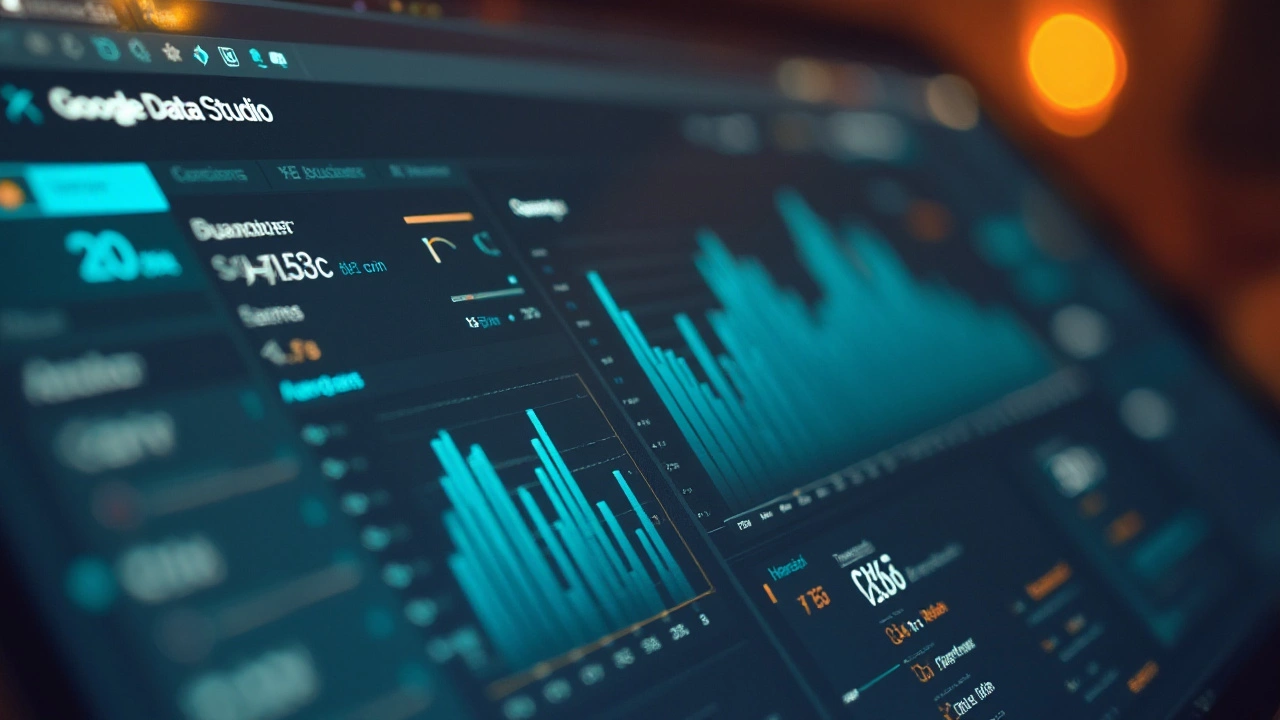The world of digital marketing is ever-evolving, with data becoming the backbone of informed decision-making. As marketing professionals grapple with an influx of numbers, turning these into visual, digestible information has never been more crucial. Enter the custom Google Data Studio dashboard—a dynamic tool capable of not only streamlining data but supercharging your return on investment overnight.
Integrating cutting-edge technology with intuitive design, these dashboards seamlessly collate diverse data streams into comprehensive visuals. This not only enhances clarity but empowers teams to act swiftly on insights, driving significant ROI improvements within a single day.
- The Rise of Custom Dashboards
- Expert Insights from Gregory Charny
- Key Metrics to Watch
- Future Trends in Data Visualization
The Rise of Custom Dashboards
In today's expansive digital landscape, the power of data cannot be overstated. With businesses of all sizes striving to gain a competitive edge, leveraging data insights has become indispensable. The emergence of Google Data Studio revolutionized how marketers understand and interact with their data. However, in recent times, the trend is shifting towards even more refined tools - the custom Google Data Studio dashboard. As traditional dashboards often deliver static, one-size-fits-all metrics, a customized approach tailors visuals and data points to meet specific business needs, leading to unprecedented ROI spikes.
The popularity of these bespoke dashboards owes much to their unparalleled ability to navigate through multiple data sources, fuse them, and then present them coherently. This digitization era demands quick yet insightful decisions, and it's here that personalized dashboards excel. They are adept at tracking real-time performance, enabling businesses to react promptly, fine-tune their strategies, and consequently enhance their monetary outcomes. A marketer today can transition from a sea of numbers into a crystal-clear narrative that supports dynamic strategy shifts. This adaptability is crucial in a phase where customer behavior can pivot on a dime, affecting an enterprise's financial health and customer rapport.
Perhaps the appeal also lies in the visual clarity these tools offer. Gone are the days when cluttered spreadsheets ruled. Instead, custom dashboards present needed information in engaging graphs and visuals that are easy to digest. This doesn't merely aid marketing professionals; it also enriches boardroom discussions, aiding leadership teams in making informed strategic decisions without delving into the nitty-gritty of raw data. In this regard, Google's Data Studio plays the role of an artist's canvas, with marketers as the artists, painting a picture of their business health in real time.
"Digital transformation is rapidly reshaping the marketing world. Custom dashboards aren’t just about aesthetic data representation; they're pivotal for gleaning actionable insights," remarked Emily Grant, a seasoned digital marketing expert, during a recent media panel on digital tools for enhanced marketing.
Moreover, the implementation and operational costs associated with these dashboards are relatively modest compared to traditional business analysis approaches. This affordability ensures that even small and medium-sized enterprises can harness the power of data-driven strategies without substantial financial outlay. As more tools emerge to make customization more accessible, businesses are seizing opportunities to tailor every data point that could affect their bottom line.
Looking at the transformative capacity of custom dashboards, it's evident that their evolution is just beginning. As artificial intelligence and machine learning become further integrated into these systems, the personalization of dashboards will reach new heights. This progression signifies an exciting era for businesses eager to extract maximum value from their data. The notion isn't just about seeing numbers; it's about comprehending their story and translating it into actionable, impactful strategies. With the landscape constantly evolving, those with foresight who invest in and adapt to these tools will undoubtedly carve a niche for themselves in their industry.

Expert Insights from Gregory Charny
Gregory Charny, renowned in the marketing world for his forward-thinking strategies, offers a unique perspective on why custom Google Data Studio dashboards are reshaping the industry. According to Charny, the integration of such dashboards is akin to giving businesses a new set of eyes—ones that see clearly and act quickly. He emphasizes that creating a tailored dashboard is more than just displaying numbers; it’s about transforming data into a narrative that guides strategic decisions. The real-time nature of these marketing dashboards, he notes, provides an unprecedented advantage, allowing marketers to navigate the turbulent seas of ever-shifting digital trends.
Charny explains that at its core, a custom Google Data Studio dashboard leverages the technology's capability to amalgamate data from various sources into a unified dashboard, offering a holistic view. He stresses the importance of customization, pointing out that no two businesses are the same—a sentiment echoed by his peers—and therefore their dashboards shouldn't be either. "A custom dashboard," he says, "is the compass every marketing team needs to ensure they are on the right path to maximizing ROI. It’s about having the right tools to measure, predict, and act in real time."
Charny is not alone in his beliefs. Across the industry, thought leaders are acknowledging the transformative power these dashboards have. A recent study showed that companies using tailored dashboards reported a 20% increase in efficiency within months of adoption. This, says Charny, is a testament to the changing landscape of data visualization. He underlines the notion that in today’s fast-paced world, where consumer behavior can pivot overnight, having instant access to actionable insights is no longer a luxury—it's a necessity.
The ability to visualize data is like turning a light on in a dark room—it illuminates opportunities that were hidden just moments before.
Charny believes that as technology evolves, so too must our tools. He sees the future of data dashboards as more interactive, predictive, and user-friendly. This evolution is not just about keeping up with technology but staying ahead of it, ensuring marketers are not only reacting to change but also anticipating it. By continually refining these data visualization tools, businesses can stay agile, make informed decisions quickly, and keep their competitive edge sharp.

Key Metrics to Watch
In the intricate web of digital marketing, identifying the right metrics is of paramount importance. With a custom Google Data Studio dashboard, marketers are equipped not just to gather data, but to pinpoint the exact metrics that drive performance. The emphasis on what's known as "vanity metrics" often misleads, masking the critical insights that truly impact ROI. So which metrics deserve our unwavering attention in the pursuit of maximizing returns?
First and foremost, conversion rate remains a cornerstone of any effective marketing strategy. This metric provides a clear reflection of how well your campaigns are driving desired actions, like purchases or sign-ups. Distilling this information through a custom dashboard, teams can identify campaign bottlenecks and optimize their strategies in real-time. Coupled with a keen eye on click-through rates (CTR), these metrics provide insights into not only audience engagement but also the effectiveness of various messages and channels in drawing user interaction.
Equally pivotal is the monitoring of customer acquisition cost (CAC). With marketing budgets always under scrutiny, understanding how much you're spending to attract new customers is essential. A streamlined Data Studio dashboard allows businesses to compare CAC against customer lifetime value (CLV), enabling strategic adjustments to acquire more valuable customers at a lower cost. Exploring these metrics can reveal hidden inefficiencies or opportunities within campaigns that might otherwise remain unnoticed.
Chris Penn, VP of Marketing Technology at Trust Insights, once said, "Maximizing ROI isn't just about understanding what works, it's about knowing why it works and where to take action next."
Another metric not to overlook is the engagement rate on social media platforms. This goes beyond simple likes and shares, as it uncovers how audiences are truly interacting with your content over time. A strong engagement rate indicates a higher level of interest and loyalty which can translate to better retention rates and ultimately, increased ROI. When analyzed through a Google Data Studio dashboard, these engagement metrics are visualized alongside website traffic data, giving marketers a fuller picture of audience behavior.
Lastly, the rapidly growing importance of mobile traffic should not be ignored. With more users accessing content via mobile devices, keeping a close watch on mobile engagement metrics versus desktop is essential. Data Studio dashboards can effectively create side-by-side comparisons, helping marketers decide where to allocate resources—and further enhancing the overall data visualization process.
Additional Points of Consideration
An often overlooked but crucial metric is the bounce rate. Understanding why users leave without engaging can be as informative as any success metric. Identifying patterns and trends in bounce rates can help refine content and improve user experience across platforms. Regularly updating your dashboard to reflect the latest metric insights will ensure that your marketing strategies remain agile and responsive to market changes.
"Data is only as useful as the insights you can draw from it," says Kristen McCormick, Senior Content Marketing Manager at WordStream. "Your Google Data Studio dashboard should be an evolving tool that grows with your business."
In conclusion, leveraging the power of a Google Data Studio dashboard by focusing on these key metrics can dramatically enhance your marketing ROI. By continuously refining and analyzing the data, businesses can achieve not only short-term gains but sustainable growth that meets long-term objectives.

Future Trends in Data Visualization
The landscape of data visualization is evolving at an unprecedented pace, with many groundbreaking trends set to define the next era of digital marketing. At its core, data visualization is transcending traditional pie charts and bar graphs, morphing into interactive, immersive experiences that engage audiences more intuitively. Interactive dashboards are playing a pivotal role in this transformation, offering real-time updates and predictive analytics that are crucial for swiftly adapting marketing strategies.
Another dynamic aspect gaining momentum is the use of Artificial Intelligence to power visualization tools. AI algorithms can efficiently parse complex datasets, identifying patterns and forecasts that might otherwise be missed by human analysts. This not only enhances accuracy but provides businesses with a competitive edge, allowing them to anticipate market shifts and consumer behavior. In an industry as fast-paced as marketing, the ability to foresee trends and pivot accordingly could mean the difference between success and stagnation.
Google Data Studio itself epitomizes this shift toward AI-driven insights. By leveraging AI capabilities, this tool can synthesize vast amounts of information, presenting it through customizable dashboards that cater to user-specific needs. The future promises enhanced personalization, where each user can tailor their data visualization experience according to sector-specific demands or individual preferences. A quote from Charny Gregory encapsulates the essence of this trend:
"The real power of AI in data visualization lies in its ability to transform the myriad of data into actionable intelligence—no longer is data just about numbers, it's about narrating a story that drives business decisions."
Visual storytelling, in particular, is emerging as a key component of future trends. Marketers are increasingly recognizing the importance of narrating a story with data—moving beyond mere static figures to engaging, narrative-driven insights that resonate with audiences on an emotional level. This trend is being driven by the desire to connect with audiences more meaningfully, using data to craft compelling narratives that highlight the human element behind the numbers.
To accommodate these new data visualization needs, emerging technologies are also focusing on enhancing user experience and accessibility. Tools are becoming more intuitive, ensuring that even those without technical backgrounds can unlock their potential. This democratization of data means that smaller businesses, not just tech giants, can harness the power of advanced data visualization, leveling the playing field across industries.





